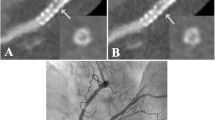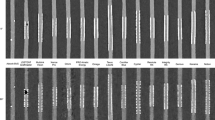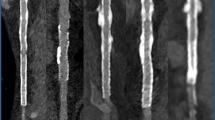Background:
The number of patients with obstructive coronary artery disease, who undergo coronary angioplasty with implantation of stents, is ever increasing. As an alternative to catheter-based angiography, ECG-gated multi-slice spiral computed tomography (MSCT) allows noninvasive imaging of the coronary arteries. However, coronary stents have been notoriously difficult to assess by CT.
Methods and Results: In vitro experiments were performed, using varying detector collimations, contrast concentrations, stent positions and stent diameters, to evaluate the feasibility and image characteristics of stents. The stent-related highdensity artifacts expand the apparent size of the stent struts. This blooming effect is a fairly constant phenomenon, and therefore relatively less evident in larger-diameter stents. The in vivo images show the same artifacts, but assessment is further complicated by motion, lower contrast-to-noise, and vessel wall calcifications.
Conclusions: The clinical value of CT after percutaneous coronary intervention currently remains largely limited to the detection of stent occlusion, and the progression of coronary artery disease in the remaining nonstented segments. Subtle in-stent abnormalities cannot be reliably imaged. Some relief will be offered by improvements in scanner technology, but the use of less radiopaque stent material would be more effective.
Hintergrund:
Die Anzahl von Patienten mit stenosierender koronarer Herzerkrankung, bei denen eine Stentimplantation erfolgte, steigt stetig an. Als Alternative zur Katheter-basierten Angiographie, kann die EKG-gesteuerte Multi-Slice-Spiral-Computertomographie (MSCT) nichtinvasiv die Koronararterien darstellen. Die Beurteilung von Koronarstents mittels CT ist jedoch schwierig.
Methoden und Ergebnisse: Um die Bildcharakteristik der Stents zu evaluieren, wurden In-vitro-Untersuchungen mit unterschiedlichen Kollimationen, Konzentrationen der Kontrastmittel, Stentpositionen und Stentdurchmessern durchgeführt. Die stentbedingten Artefakte bei hohen Dichten überschätzen die wahre Größe der Stents. Dieser “Blooming”-Effekt ist ein ziemlich konstantes Phänomen und steht bei größeren Stentdurchmessern weniger stark im Vordergrund. Die In-vivo-Bilder zeigen die gleichen Artefakte, die Beurteilung der Stents ist jedoch durch die Bewegung, das niedrigere Kontrast-zu-Untergrund-Verhältnis und Kalzifizierungen der Gefäßwand komplexer.
Schlussfolgerung: Der klinische Wert der CTs nach Koronarinterventionen bleibt gegenwärtig zur Erkennung eines Stentverschlusses bzw. einer Progression der koronaren Herzerkrankung im nicht gestenteten Segment limitiert. Eine Feindiagnostik innerhalb des Stents kann nicht zuverlässig durchgeführt werden. Möglicherweise können diese Probleme durch neuere Technologien reduziert werden – effektiver jedoch wäre die Verwendung von weniger kontrastreichen Stents.
Similar content being viewed by others
Author information
Authors and Affiliations
Additional information
Correspondence Address Koen Nieman, MD, Department of Cardiology, Thoraxcenter Bd 410, Erasmus Medical Center, PO Box 2040, 3000 CA Rotterdam, The Netherlands, Phone (+31/10) 439-1608, Fax -4320, e-mail: koennieman@hotmail.com
Rights and permissions
About this article
Cite this article
Nieman, K., Cademartiri, F., Raaijmakers, R. et al. Noninvasive Angiographic Evaluation of Coronary Stents with Multi-Slice Spiral Computed Tomography. Herz 28, 136–142 (2003). https://doi.org/10.1007/s00059-003-2446-3
Issue Date:
DOI: https://doi.org/10.1007/s00059-003-2446-3




